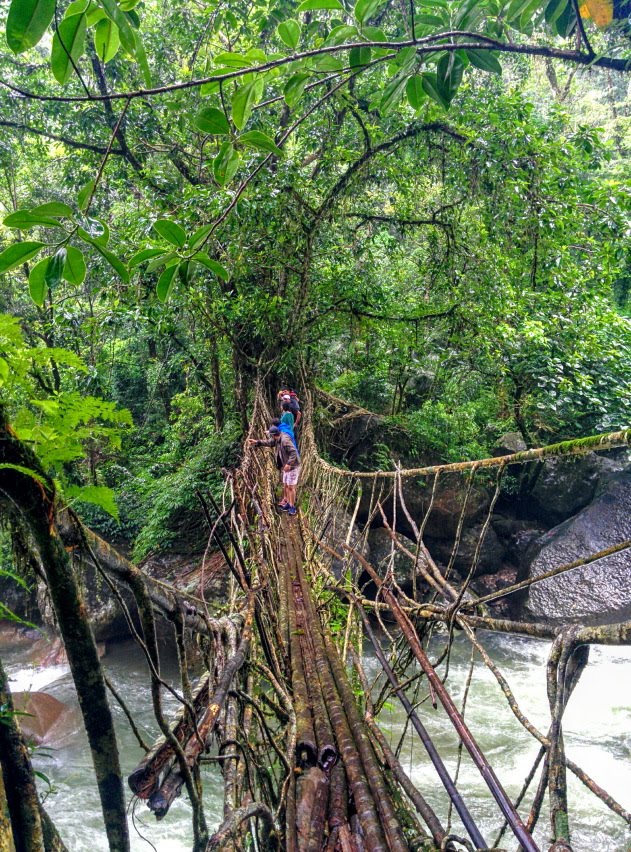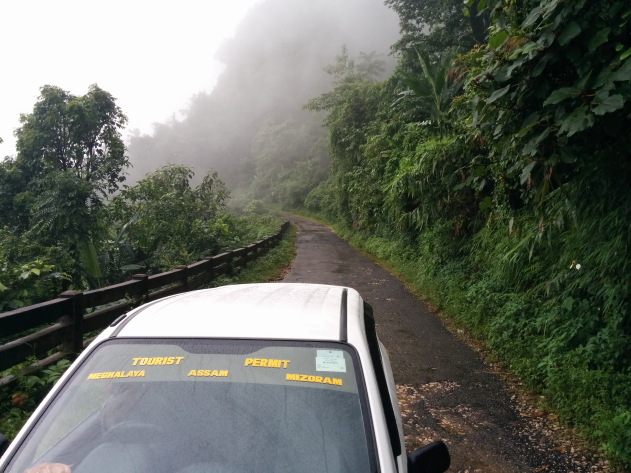Monsoon Holiday to Meghalaya’s Living Root Bridges

What better way to spend your monsoon holiday than in the state that is called as the ‘land of the clouds’ and in the wettest region in the world? You got it right! I am referring to Meghalaya’s Cherrapunji region where rains don’t take a break for three months and where clouds merge one with the land.

While nearly everyone knows about Cherrapunjee region’s iconic status as the wettest region in the world, not all know about the ancient Khasi tradition of building bridges from roots of trees. Or may be, many know due to the sheer publicity that this place receives these days. :-)

In case you wish to know the story…The families of Khasi tribes have passed on traditional bridge architecture knowledge down their family tree for generations. This knowledge teaches them to use the roots of the rubber tree and train them to entwine into strong bridges over a period of many years. Usually, these bridges connect remote Khasi tribal villages and should allow free movement of people and goods all round the year. As a thumb rule, locals identify places where native rubber trees are present on either bank of the fast flowing, but narrow mountain river. They then, try and direct the roots of these rubber trees towards each other. What follows next is a wait of many years where these living roots are directed like climbers till they form sturdy bridges that can easily carry 20 to 40 people with loads on their backs.

Having stood on these bridges over two separate trips, I can easily vouch that they are way stronger than steel rope bridges, feel more safe and definitely feel sturdier. And the best part is that these bridges are still growing, which means that they potentially will last a very long time with minimal wear, tear and maintenance. And, because these well trodden bridges are akin to national highways for these villages, they don’t gather moss or turn slippery even during the heaviest of rains. Now, that is truly eco friendly bridge architecture, a treat to the eye, a photographer’s delight and an adventurer’s thrill.

As far as I know, there are close to 36 such living root bridges in this region of Meghalaya, each providing access to different Khasi villages. In addition to these 36 fully operational living root bridges, there are many more that are under construction. Some of these bridges are small, while some of them are as long as 100 feet, but the one that takes the cake is the double decker living root bridge at Nongriat village.

If you are planning on experiencing the iconic living root bridges of Meghalaya, you should definitely plan to see the double decker one at Nongriat. While each of these living root bridges look beautiful, the one to Nongriat requires you to climb down close to 3000 stone steps, cross two swaying steel rope bridges over raging mountain rivers and white water, cross a small living root bridge, walk through tiny remote villages and walk through pristine lush green vegetation that is a high in itself.

During the monsoons, the rains are omnipresent, the rivers are roaring and nature is at its prettiest best! This is possibly the best time to see these living root bridges of Meghalaya in Technicolor. Even though this was my third trip to Meghalaya and the 2nd trip to the living root bridges, this was my first trip during the monsoons and I have to say that I enjoyed every bit of exploring these tiny hamlets in persistent rains.

From the time you start at the church in Tyrna village where the descent to Nongriat begins to the time you are actually walking on the double decker bridge, you will take anywhere between 60 and 120 minutes one way. Add 30 to 60 minutes extra for the detour to the longest (100 feet long) living root bridge at Nongthymmai, 30 to 60 minutes extra for photography and 30 to 90 minutes more for breaks. It is the steep climb on the way back that will make your quadriceps groan and your heart pound, but when walking towards the village, do not think about this climb, but soak in the view of the wild orchids, flowers and bountiful nature, revel in the adventure of crossing high steel rope bridges that can sway sideways from time to time and just simply enjoy walking in the rains.
Once you reach Nongriat, do take a dip in the stream under the double decker bridge and if you have some gas left in the tank, head further to the Rainbow falls and swim in its gorgeous pools. On your way back, chomp into some hot piping maggi noodles or omelette and wash it down with a hot cup of tea. The pace of life is slow here and it feels like your life force is rejuvenating itself even though you have just spent oodles of energy climbing up and down the steep trails to this village. And that is why a lot of people stay back in this village and spend a good part of their holiday in pristine remoteness.

In addition to Nongriat, there are other living root bridges nearby such as the ones at Umkar, Umunoi and Laitkynsew that you can explore and experience in this region. And while you are enjoying these adventures in Meghalaya’s living root bridge villages, do spend some time conversing with locals and learning about their unique Khasi cultures and traditions. In simple words, make it a monsoon holiday like no other!

Remember this golden piece of advice…even if people scare you about the climb down and up to the double decker living root bridge of Nongriat, do try to experience these living root bridges as they are really some sight and definitely doable even for the person with basic fitness levels. The trail is not slippery, there are hand rails to take support, wooden staff available on rent and guides available to help you in case of any trouble.
If there is one monsoon holiday that I have to recommend, it has to be the living root bridges of Meghalaya! I hope you get to live it this year or in the years to come. I have laid out a small guide and some handy tips below to help you with your overall planning.
What other attractions can I see:

Apart from the iconic living root bridges, one can indulge in a lot of water based activities, but considering the heavy flow of water, watersports are usually not recommended in the monsoons. Instead, one can indulge in the umpteen sightseeing options present nearby.
1) Noh Kalikai Falls – one of the tallest single plunge waterfalls in India. If you feel adventurous, you can trek all the way down to the bottom of the waterfalls
2) Thangkharang Park – for its canyons and waterfall views
3) Mawsmai cave – for the eerie stalactites and stalagmites
4) Mawlynnong – for Asia’s cleanest village
5) Dawki – for views of Bangladesh’ flood plains
6) Laitkynsew – for a traditional Khasi village exploration
7) Many other view points, but again that depends on your luck as most view points will be enveloped in thick cloud cover or mist.
Where to Stay:

If the living root bridges are specifically on your agenda, you should either stay in Nongriat village or somewhere near by. But, do remember that, the only way for you and your luggage to reach Nongriat is by foot. You can hire porters to carry your luggage, but do plan for that well in advance with the homestay/guest house that you are staying with. Nongriat’s Serene Homestay comes heavily recommended by fellow travelers, though I did not stay there. The village is a great place to stay if pristine nature is your thing, but do remember that facilities will be basic.
If you do not wish to stay in Nongriat, but still wish to be in close proximity to all the living root bridges, plan to stay at the Cherrapunjee holiday resort at Laitkynsew village. This comfortable property, located amidst pristine views is easily accessible to close to 8 living root bridges, either by foot or at max a 10 minute drive by car. I stayed at this property for 5 days and made many day trips to different living root bridges, Khasi villages and view points. And at the end of my physically tiring day, I returned to a warm room, running hot water and delicious food.
If you seek luxury, stay in and around the Cherrapunjee area. But, to reach the living root bridges, make sure you start your day a bit early and keep a car with you at all times as all living root bridges are at least an hour away from Cherrapunjee.
How to reach here:

Shillong is the closest airport, though a lot of people prefer Guwahati due to lower fares. If only Meghalaya is on your itinerary, I would recommend flying into Shillong rather than Guwahati. This will help you avoid Guwahati traffic, Shillong traffic and the drive from Guwahati to Shillong on both your way in and out.
From Shillong, one can easily find taxis and shared taxis to Cherrapunji. A shared taxi costs about 80 rupees per person. The journey takes about 2 hours, but the vehicle leaves only when it is full. If you wish to hire a full vehicle such as a Maruti Alto, it will cost you INR 600 rupees to Cherrapunjee and INR 1200 up until Tyrna village from where the trek to Nongriat begins. You can also negotiate in case you wish to do some sightseeing stops enroute. These Shillong taxi drivers are much cheaper than hiring a car full time, unless you plan to drive it.
Hire a full vehicle only if you plan on seeing many places and are on a very short trip. If not, it is economical to hire a vehicle when needed. A lot of local taxis are available at your beck and call and all rates are fixed. Plus, this also gives you the excuse to walk more.
Handy Packing Tips:

If you are visiting Meghalaya during the monsoons, do expect very heavy to extremely heavy rains. An umbrella becomes a necessity and will come in handy almost always, though it can be a bit tricky to use while crossing steep rope bridges and on slippery surfaces. Raincoats and waterproof jackets are also nice, but due to the high humidity, I would not recommend that. Even though you will be hiking and walking a lot, I would not recommend wearing boots. Instead, I would recommend waterproof sandals or quick drying shoes. Personally, I walked with flip flops and honestly, I was very happy with my choice. As clothes do not air dry at all, don’t bother with thick cottons or any heavy material. Rather, wear those kind of clothes that dry super quick. Evenings and early mornings can get nippy from time to time. Hence, carry a light jacket or jumper to keep you warm when you are in a dry environment. You don’t need any warm wear during the hike.
What to bring back home as Souvenirs:
Wild forest honey of this region is a specialty. So are turmeric and bay leaves. I have bought them and can hence can personally vouch for its supreme quality. The honey is so good that I am kicking myself for not buying some more. Local weaves are also very popular, especially the traditional tribal designs. And while you are there, do chomp on some uber juicy and delicious pineapples and plums as they come in season during the rains.



































